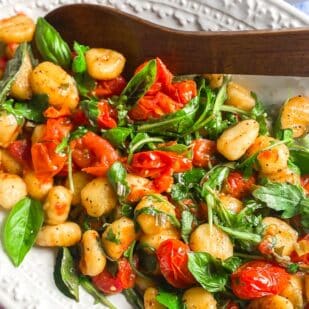
Low FODMAP Roasted Gnocchi With Tomatoes, Basil & Arugula
Are you a gnocchi fan? Our Low FODMAP Roasted Gnocchi With Tomatoes, Basil & Arugula takes advantage of a potato-based purchased gnocchi that is low FODMAP and happens to be gluten-free, too. This recipe roasts the gnocchi in the oven after a good toss in Garlic-Infused extra-virgin olive oil. The gnocchi develop a little bit of a toothsome crust but remain tender in the middle. It is now our preferred way of preparing purchased gnocchi!
Ingredients:
- 17.6- ounce (or 1-pound [455 g] package Le Veneziane Gluten Free Potato Gnocchi
- ¼ cup (60 ml) Garlic-Infused Oil, made with olive oil, divided
- 2 pints (680 g) cherry or grape tomatoes
- ½ cup (32 g) chopped scallions, green parts only
- ½ teaspoon kosher salt, plus extra
- Freshly ground black pepper
- 2 cups (40 g) arugula
- 1 cup (15 g) fresh basil leaves
- 1 tablespoon lemon juice, red wine vinegar or balsamic vinegar
- ¼ cup (25 g) grated Parmesan; optional
Preparation:
-
Position rack in middle of oven. Preheat oven to 425°F (220°C). Have a half-sheet pan ready to use.
-
Scatter the gnocchi on the pan and drizzle with 3 tablespoons of the oil; toss well to coat. Toss in tomatoes and scallion greens, then spread out in an even layer. Season with ½ teaspoon salt and with pepper to taste (we like a lot).
-
Roast for 25 to 30 minutes or until tomatoes are burst and the gnocchi has a bit of a crust (taste on to find out). Meanwhile, place the arugula, basil, lemon juice or vinegar, remaining 1 tablespoon of Garlic-Infused Oil in a bowl, season with salt and pepper, and toss well.
-
Remove from oven. Scatter the greens on top of the gnocchi, with all the dressing, and toss well. Sprinkle with Parmesan cheese, if you like. Serve immediately.
Notes:
FODMAP Information
All recipes are based upon Monash University & FODMAP Friendly science at time of initial publication.
• Arugula: Monash university has lab tested arugula. For many years they stated that arugula had no FODMAPs. After a 2019 smartphone app update, they changed the entry to say that arugula contains trace amounts, but still state, “east freely and according to appetite”.
• Garlic-Infused Oil: Make your own Garlic-Infused Oil or buy a commercial equivalent for the easiest way to add garlic flavor to your food. Fructans in garlic are not oil-soluble, so garlic-infused oil is low FODMAP.
• Herbs: Many fresh and dried herbs have been lab tested by both Monash University and FODMAP Friendly and are easily looked up in the apps, which we strongly suggest that you have. The additional good news is that if you are interested in an herb that has not been lab tested, you can look at the nutritional panel and assess its FODMAP load for yourself. If the “Sugars” and/or “Carbs” are 1 g or less per serving, then the item would be a good bet to try.
• Lemon Juice: Monash University has lab tested lemon juice and it is low FODMAP in 1/2 cup (125 g) amounts.
• Scallions: Monash University lab testing found no FODMAPs detected in scallion greens; they suggest a 75 g serving size. FODMAP Friendly has also lab tested scallions: their recommended serving size for the green parts is 16 g, with a max low FODMAP serving of 161 g. They have also tested the bulb and it is low FODMAP in 19 g portions, which is about 2 tablespoons finely chopped.
• Tomatoes: Tomatoes: Both Monash University and FODMAP Friendly have lab tested several kinds of tomatoes, numerous times. In earlier lab tests for common, beefsteak tomatoes, Monash University stated that their lab tests showed no FODMAPs. In later tests (now called just “common tomato”), the results suggest about ½ medium tomato or 65 g are low FODMAP. FODMAP Friendly gives them a “Pass” at ½ cup (75 g) portions and suggests up to 84 g are low FODMAP. Earlier lab tests by Monash for Roma (plum) tomatoes stated low FODMAP servings of 75 g, which is about 1 small tomato or ½ cup. Later tests state 48 g are low FODMAP, or about 2/3 tomato. FODMAP Friendly recommends 75 g is low FODMAP, with a serving up to 108 g being low FODMAP. For Cherry tomatoes, earlier lab tests by Monash showed that 75 g of cherry tomatoes are low FODMAP (about 5 or ½ cup); later tests say 3 tomatoes or 45 g are low FODMAP. FODMAP Friendly states that 75 g are low FODMAP, with a max serve of 750 g being low FODMAP. Yes, these results are all over the map. Tomatoes vary hugely in sugar content, even variety to variety, and neither testing body has told us what varieties they tested. Use any of these accurate lab test results as a place to begin your exploration of your relationship to FODMAPs in tomatoes.
Please always refer to the Monash University & FODMAP Friendly smartphone apps for the most up-to-date lab tested information. Foods will be retested from time to time; in the case of raw ingredients, such as fruits and vegetables, results may vary. All lab tested results are valid and represent a snapshot in time. As always, your tolerance is what counts; please eat accordingly. The ultimate goal of the low FODMAP diet is to eat as broadly as possible, without triggering symptoms, for the healthiest microbiome.